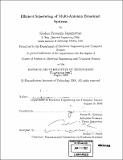| dc.contributor.advisor | Eytan H. Modiano. | en_US |
| dc.contributor.author | Jagannathan, Krishna Prasanna | en_US |
| dc.contributor.other | Massachusetts Institute of Technology. Dept. of Electrical Engineering and Computer Science. | en_US |
| dc.date.accessioned | 2007-08-03T18:30:11Z | |
| dc.date.available | 2007-08-03T18:30:11Z | |
| dc.date.copyright | 2006 | en_US |
| dc.date.issued | 2006 | en_US |
| dc.identifier.uri | http://hdl.handle.net/1721.1/38325 | |
| dc.description | Thesis (S.M.)--Massachusetts Institute of Technology, Dept. of Electrical Engineering and Computer Science, 2006. | en_US |
| dc.description | Includes bibliographical references (p. 65-67). | en_US |
| dc.description.abstract | In this thesis, we study the problem of efficiently scheduling users in a multi-antenna Gaussian broadcast channel with 1M transmit antennas and K independent receivers each with a single receive antenna. We first focus on a scenario with two transmit antennas and statistically identical users, and analyze the gap between the full sum capacity and the rate that can be achieved by transmitting to a suitably selected pair of users. In particular, we consider a scheme that picks the user with the largest channel gain., and selects a second user from the next L - 1 largest ones to form the best pair, taking the orientation of channel vectors into account as well. We prove that the expected rate gap converges to 1/(L - 1) nats/symbol when the total number of users K tends to infinity. Allowing L to increase with K, it; may be deduced that transmitting to a properly chosen pair of users is asymptotically optimal, while dramatically reducing the feedback overhead and operational complexity. Next, we tackle the problem of maximizing a weighted sum rate in a scenario with heterogeneous user characteristics. | en_US |
| dc.description.abstract | (cont.) We establish a novel upper bound for the weighted sum capacity, which we then use to show that the maximum expected weighted sum rate can be asymptotically achieved by transmitting to a suitably selected subset of at most MC users, where C denotes the number of distinct user classes. Numerical experiments indicate that the asymptotic results are remarkably accurate and that the proposed schemes operate close to absolute performance bounds, even for a moderate number of users. | en_US |
| dc.description.statementofresponsibility | by Krishna Prasanna Jagannathan. | en_US |
| dc.format.extent | 67 p. | en_US |
| dc.language.iso | eng | en_US |
| dc.publisher | Massachusetts Institute of Technology | en_US |
| dc.rights | M.I.T. theses are protected by copyright. They may be viewed from this source for any purpose, but reproduction or distribution in any format is prohibited without written permission. See provided URL for inquiries about permission. | en_US |
| dc.rights.uri | http://dspace.mit.edu/handle/1721.1/7582 | |
| dc.subject | Electrical Engineering and Computer Science. | en_US |
| dc.title | Efficient scheduling of multi-antenna broadcast systems | en_US |
| dc.type | Thesis | en_US |
| dc.description.degree | S.M. | en_US |
| dc.contributor.department | Massachusetts Institute of Technology. Department of Electrical Engineering and Computer Science | |
| dc.identifier.oclc | 154318236 | en_US |
